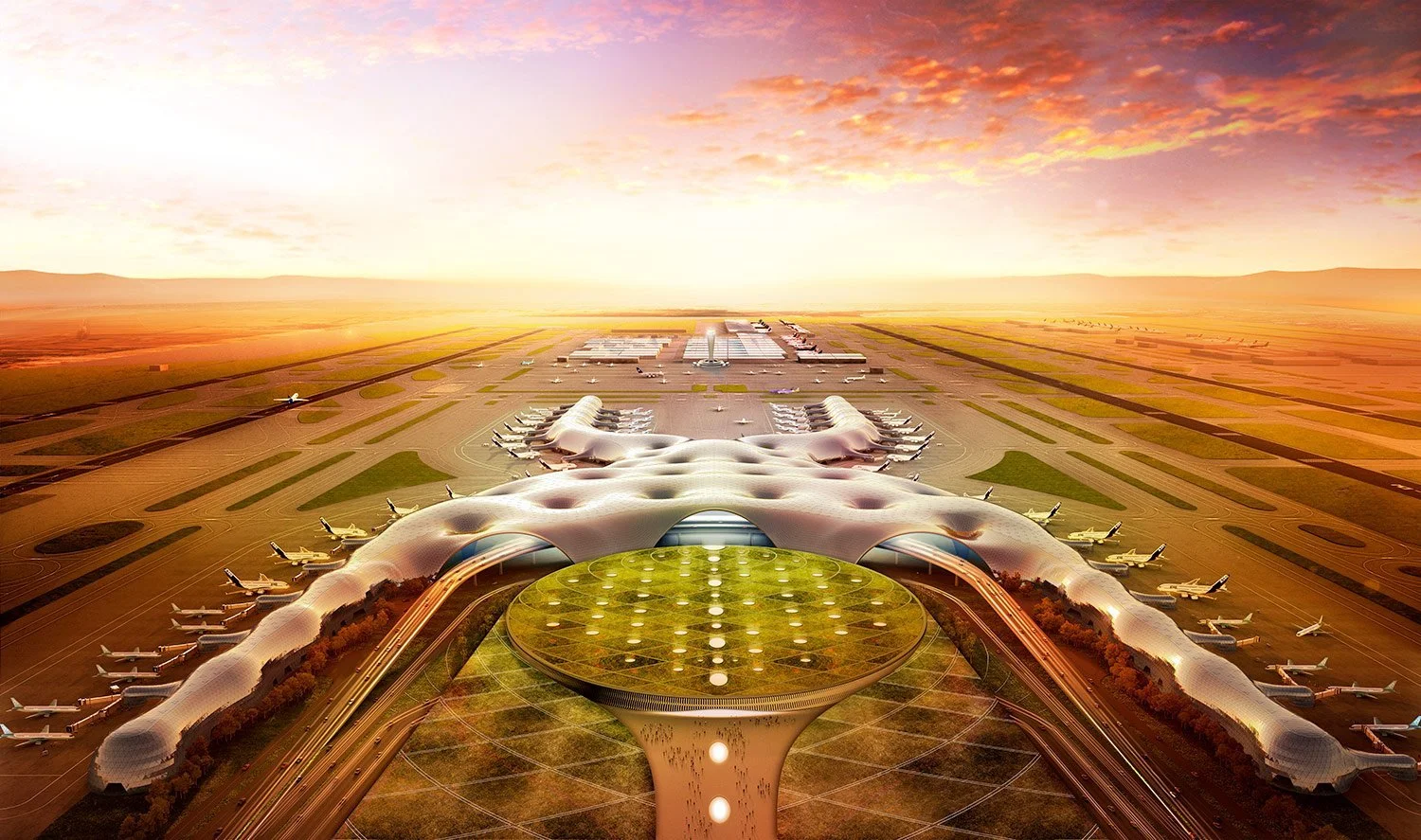Mexico City International Airport
Project Status: Cancelled
Project Year: 2020
Use: Airport
Client: Federal Government
Area: 743,000 m2
Location: Mexico City
Design: Mauricio Ceballos, FR-EE, Foster+Partners
Team: Foster + Partners, FR-EE, Arup, NACO, Gleeds, Three, Pragma, AKF, Gehry Technologies

Context
In spring 2014, the federal government of Mexico under President Enrique Peña Nieto launched an international competition that would become one of the most significant infrastructure initiatives in Latin American history. The competition invited global participation for what was framed as the largest infrastructure development on the continent, signaling Mexico's ambition to create a transformative project of international significance. This governmental commitment represented more than a routine infrastructure upgrade; it embodied national aspirations to modernize critical transportation infrastructure, enhance Mexico's global connectivity, and create a landmark that would represent the country's forward-looking vision on the world stage.
The project emerged from pressing operational needs combined with aspirational goals for what an airport could represent and achieve. Mexico City's aviation infrastructure faced capacity constraints and functional limitations that threatened to constrain the capital's economic growth and international connections. Beyond addressing these immediate operational challenges, the project aspired to fundamentally reimagine what airport design could be and how the travel experience might be transformed. The ambition extended beyond creating adequate facilities to envisioning a building and infrastructure that would meet the complex demands of 21st-century aviation while establishing an enduring icon for Mexico—architecture that would transcend its functional purpose to become a symbol of national identity and achievement.
The team assembled to realize this vision brought together complementary expertise spanning multiple continents and disciplines. Leadership was provided by Mauricio Ceballos and Norman Foster, combining perspectives from different design cultures and professional contexts. The collaboration united Foster + Partners, the UK-based firm founded by Pritzker Prize-winning architect Lord Foster, with FR-EE, the Mexico and US-based practice founded by renowned architect Fernando Romero (FAIA). This partnership balanced global architectural expertise with deep understanding of Mexican context, ensuring the design would be simultaneously world-class and culturally grounded. The team's composition reflected the project's dual nature as both an international infrastructure node and a distinctly Mexican landmark.
The architectural partnership was complemented by specialized aviation expertise through close collaboration with NACO, Netherlands Airport Consultants B.V., recognized as the world's premier airport planning firm. NACO's extensive experience across more than 500 international airports provided the technical foundation necessary to translate architectural vision into operationally viable infrastructure. This collaboration ensured that aesthetic ambitions would be balanced with functional requirements, passenger flow optimization, airline operational needs, security protocols, and the countless technical considerations that determine whether an airport design succeeds or fails in practice. The integration of world-leading architectural and airport planning expertise created the conditions for achieving the project's dual objectives of revolutionary design and operational excellence.
Design Principles
The design approach centered on revolutionizing airport design and the travel experience, rejecting incremental improvements to conventional airport typologies in favor of fundamental reimagination. This ambition acknowledged that airports had become increasingly standardized and often alienating environments characterized by confusing circulation, oppressive security procedures, commercial saturation, and architectural mediocrity. The project sought to demonstrate that airports could instead be uplifting civic spaces where the inherent drama of flight is celebrated rather than bureaucratized, where circulation is intuitive rather than labyrinthine, and where architectural quality enhances rather than degrades the travel experience. This revolutionary intent required questioning assumptions embedded in decades of airport design practice and being willing to propose radically different spatial organizations and experiential sequences.
The design philosophy embraced the goal of creating infrastructure specifically calibrated to meet the demands of 21st-century aviation while anticipating future evolution. This temporal orientation recognized that airports require decades to plan, finance, and construct, yet must remain functional for many more decades after opening. The design therefore needed to respond to current operational requirements while incorporating flexibility to accommodate technological changes, evolving security protocols, shifting airline business models, and unpredictable passenger volume growth. The 21st-century framing also acknowledged contemporary values around sustainability, passenger experience, technological integration, and operational efficiency that distinguish current best practices from the assumptions that shaped earlier generations of airport infrastructure.
The aspiration to create an enduring icon for Mexico elevated the project beyond purely functional infrastructure to the realm of symbolic architecture representing national identity and achievement. This iconic ambition required design strategies that would make the building immediately recognizable and memorable while avoiding superficial formal gestures or applied decoration lacking deeper meaning. The challenge lay in creating architecture that would genuinely embody Mexican culture, landscape, or values through its fundamental spatial and structural qualities rather than through representational imagery. An enduring icon must transcend stylistic trends to achieve timeless quality, remaining compelling and relevant across generations even as tastes and fashions evolve.
The collaborative methodology brought together global expertise with local knowledge, balancing international best practices with specific cultural, climatic, and operational contexts unique to Mexico City. Foster + Partners contributed world-leading expertise in large-scale infrastructure and an established track record of acclaimed airport projects worldwide. FR-EE provided essential understanding of Mexican architectural culture, regulatory environments, construction capabilities, and cultural sensibilities that would shape how the design would be received and experienced. NACO's airport planning expertise ensured operational viability, translating architectural concepts into functional configurations that airlines, passengers, and airport operators could successfully inhabit and operate. This synthesis of complementary knowledge domains created design decisions informed by multiple perspectives, producing solutions that satisfied functional requirements while achieving architectural distinction. The result represents not the vision of a single authorial voice but rather the product of genuine collaboration where diverse expertise generates outcomes more sophisticated than any single discipline could achieve independently, fulfilling the project's ambition to create infrastructure that revolutionizes the travel experience while establishing an enduring symbol of Mexican achievement on the global stage.
